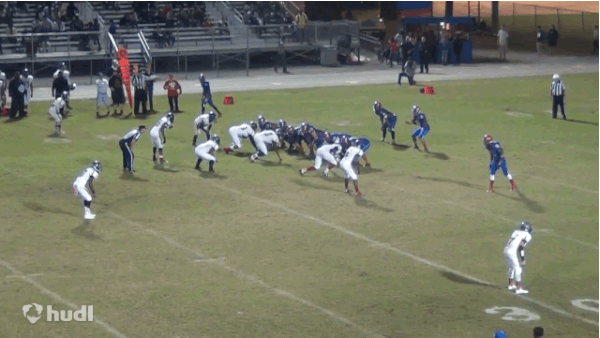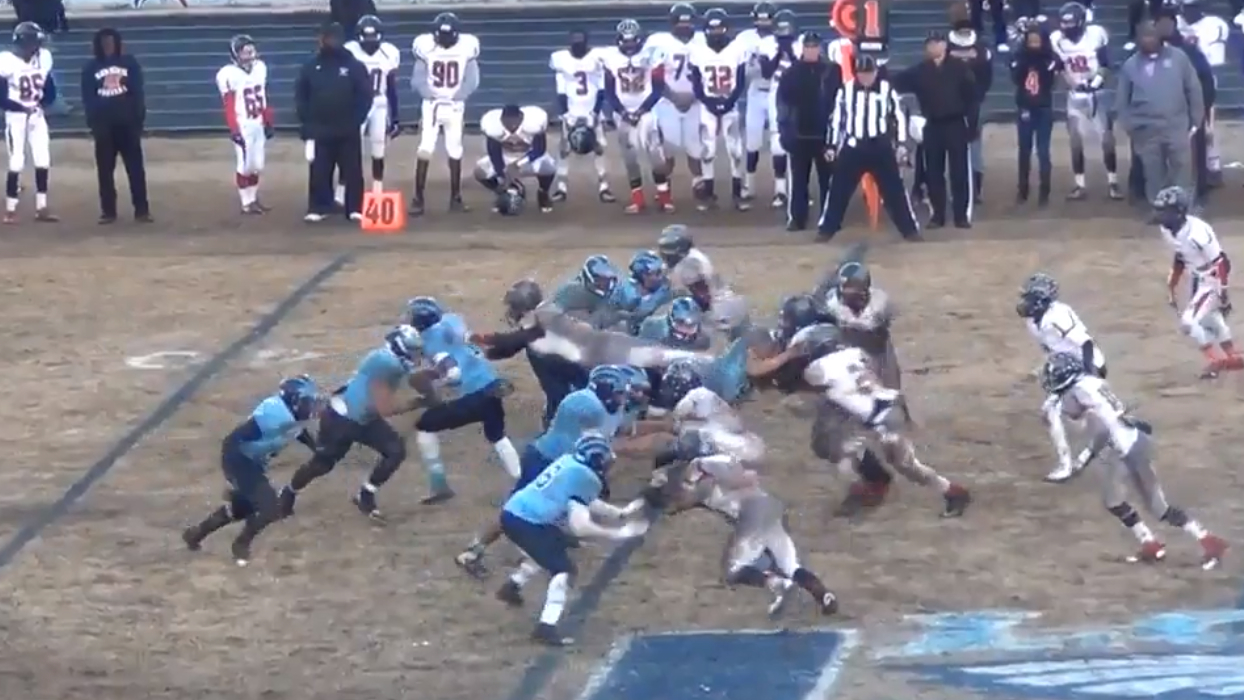On Saturday, defensive end Trevon Hill verbally committed to Virginia Tech. Defensive end is a critical need position depth wise for the 2015 class as Ken Ekanem, Dewayne Alford, and Seth Dooley are the only current defensive ends that will have eligibility in 2016. Hill, ranked as the No. 17 prospect in the Commonwealth of Virginia by the 247Sports Composite, was an all-state selection after posting 23 sacks as a junior for Salem High School in Virginia Beach. His selection of the Hokies over ACC rivals North Carolina could be a crucial turning point in what has been a slow recruiting cycle so far for Virginia Tech.
After reading that Hill was 6-4, 220, and had 23 sacks, I fully expected that Hill would be a speed rushing weak side defensive end that would use quickness to beat offensive tackles around the blind side. I was wrong in that assumption. He looks and plays like a bigger player on tape, and he is strong at the point of attack. Salem played a 3-4 defensive alignment, with Hill often aligning on the outside eye of the left offensive tackle as a five-technique end. That means instead of aligning angled and speed rushing outside of the tackle, Hill often found himself chest-to-chest working through blocks. Against spread formations and in obvious passing situations, he used more speed in space, but his straight-line speed didn't jump out on film. In fact, it is an area where he needs to improve. With that said, his technique and "bend" in his body in tight spaces allow Hill to change direction and find the football. That technique and bend makes Hill a promising prospect.
That "bend" really goes on display in pass rushing situations. Hill excels at getting into the body of the blocker, creating a leverage advantage, and then bending his body to angle into the quarterback. One of the biggest weaknesses (highlighted primarily against Maryland and UCLA) of the 2013 defensive end group was running past the pocket after gaining an initial advantage over the blocker. This created extra space which allowed the quarterback to have wide running lanes.
Hill doesn't run upfield and take a wide path to get around blocks. Instead, he collapses the pocket then takes the shortest path to the ball. He does this by quickly defeating the block through getting separation, using leverage technique, and then bending his body to turn the corner around the blocker.
Here, Salem is in their base 3-4, but Hill widens out to a 7-technique in an obvious passing situation.

Hill is quick off the snap and gets the left tackle turned to the sideline with a push through his outside shoulder. Hill then drops his hips, lowers his left shoulder, and bends underneath the block to turn into the pocket.
In the still below you can see how Hill's legs are outside of where his upper body is.

This is tremendous body control. You also should note that Hill's angle is in front, not behind the quarterback, but Hill retains outside shoulder leverage to contain the quarterback in the pocket. Once Hill turns the corner, he has long reach to wrap up the quarterback and put him on the ground.
On this next play, Hill uses a rip technique. A rip involves dropping your shoulder and then ripping your arm like a vicious uppercut underneath the shoulder of the blocker. Hill aligns as a five-technique on outside eye of the tackle.

He again gets off well on the snap, and then rips under the outside shoulder of the tackle. Most impressively, after the rip his momentum is going to the sideline, but he changes direction quickly and sharply turns the corner to collapse the pocket for the sack. Again, note that Hill is never BEHIND the quarterback. This is critical against mobile quarterbacks.
While most of Hill's high school film highlights him aligned over the left tackle, his excellent technique against the run leads me to believe that he will play over the right tackle as a "stud" end for the Hokies. Aligned over the right tackle, the stud usually is aligned against the strong side of the offense, and Bud Foster's defensive ends regularly slant into the outside gap, maintain a gap fit at the point of attack when aligned to the strong side. Also, Coach Wiles has often emphasized that he doesn't just want his defensive linemen to maintain their gap fit. He wants them to achieve their fit and then shed blocks and make plays. Hill has tremendous ability to fit his gap, create space so he can find the football, and then get off the block to make a tackle.
Let's see how Hill moves laterally and gap fits in Salem's base defense.

Salem's opponent runs a wham play, where they zone block to the play side and then pull a back side guard to gain a numerical advantage. Hill reads the zone block and crosses the face of the tackle to fit the outside gap as is his assignment. He gets great extension which delivers a blow to the blocker. This creates the space needed for Hill to see the football and shed the block. Hill recognizes that the back is cutting inside the tackle's block, so he redirects back to the inside and makes a solid tackle in the hole.
Hill plays beautiful leverage. He doesn't just defeat blockers with superior athleticism like most elite defensive line prospects, but uses his technique to gain the advantage and then uses his athleticism to finish the play. Here, Salem's opponents run a power lead at Hill from a Wing-T formation.

At the snap, Hill reads the down block of the tackle and crosses the tackle's face to the inside. At contact, Hill has perfect position. He is underneath the tackle's pads, extends his arms and stops the blocker's forward momentum. He keeps his feet active, and his extension allows him to read the play flowing back to the outside. Hill sheds back outside off the block and meets the back in the hole to make the tackle. Few outside of a defensive line coach would appreciate how solid Hill's technique is on this play.
Hill is a productive defensive end prospect who looks and plays bigger than his listed size. His technique, length, and nose for the football stand out as strengths. He doesn't have elite straight-line speed (as you can see on his highlights where he is pursuing the play over a longer distance), and he will need to add lower body strength to maintain his gap fits against Division I blockers. With defensive end depth a major concern, Hill has an opportunity to compete for a spot in the two-deep at stud end almost immediately if he can add the necessary strength and demonstrate comfort in Foster's gap fit system.


Comments
Please join The Key Players Club to read or post comments.
Please join The Key Players Club to read or post comments.
Please join The Key Players Club to read or post comments.
Please join The Key Players Club to read or post comments.
Please join The Key Players Club to read or post comments.
Please join The Key Players Club to read or post comments.
Please join The Key Players Club to read or post comments.
Please join The Key Players Club to read or post comments.
Please join The Key Players Club to read or post comments.
Please join The Key Players Club to read or post comments.
Please join The Key Players Club to read or post comments.
Please join The Key Players Club to read or post comments.
Please join The Key Players Club to read or post comments.
Please join The Key Players Club to read or post comments.
Please join The Key Players Club to read or post comments.
Please join The Key Players Club to read or post comments.
Please join The Key Players Club to read or post comments.
Please join The Key Players Club to read or post comments.
Please join The Key Players Club to read or post comments.